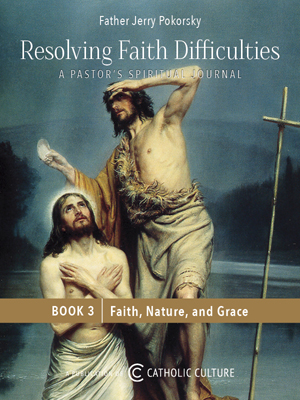The Solemnity of the Annunciation: the Moment of Incarnation in Our Lives
By Jennifer Gregory Miller ( bio - articles - email ) | Mar 24, 2015 | In The Liturgical Year
From the archives, March 2015.
With the Church we celebrate a second solemnity in the month of March and also during the Lenten season: the Solemnity of the Annunciation of the Lord. This is such a pivotal feast in our Catholic faith, and unfortunately it seems overshadowed by all the celebrations for St. Patrick and St. Joseph during March.
The Annunciation and Lent: Celebrating New Life through a Mary Garden was my post from last year. The introduction still rings true:
God chose the Blessed Virgin Mary, having prepared her without sin to be a worthy vessel for His Son. The angel Gabriel announced to Mary that she shall be the Mother of God. At the moment Mary said her “Fiat,” Jesus was conceived by the power of the Holy Spirit. This is the moment of the Incarnation, when the Word became flesh, when God assumed human nature without changing or losing His divine nature.Belief in the true Incarnation of the Son of God is the distinctive sign of Christian faith: “By this you know the Spirit of God: every spirit which confesses that Jesus Christ has come in the flesh is of God.” Such is the joyous conviction of the Church from her beginning whenever she sings “the mystery of our religion”: “He was manifested in the flesh.” (CCC #463)In this scientific age, this is truly a “pro-life” feast day. With this feast we recognize new life at its very beginnings. Science has helped to confirm how life begins at the first moment of conception. We know that the Incarnation happened at that moment Mary said “Be it done to me according to Thy word.” The Divine Seed was planted. Nine months later at Christmas, Jesus will be born and revealed publicly to the world. But at the Annunciation, even though His presence in the secrecy of Mary’s womb has only been revealed to a few souls, Christ has entered the world and begun His Redemptive mission.
This is such a pivotal moment in human history and our Catholic Faith. We tend to overlook this fact that the moment God became man the world was forever changed. This great mystery of our faith is “invisible” so to speak, and we have to use our eyes of the heart to remember, contemplate, and recognize the Incarnation in our everyday lives.
Recognizing Daily Influence
it is interesting to see how the Incarnation impacted the daily lives of the faithful. For most Christians, the practice of praying the Angelus three times a day recalling the moment of the Incarnation. And every Sunday and Solemnity the Nicene Creed is prayed, and at the words:
and by the Holy Spirit was incarnate
of the Virgin Mary,
and became man
everyone bows, or on this feast day, kneels at the solemn uttering of this moment.
And the keeping of time, with B.C. and A.D. marks that moment of Incarnation. Just entering the year when filling out a check or a form is a way to realize how time is recorded since that moment. We are living in the Year of Our Lord, 2015. We should often stop and think about the impact of the A.D..
Quarter Days
By medieval times the highlighting of this feast became part of daily life. In England and Ireland the Annunciation became one of the “Quarter Days.” These were four days a year, roughly three months apart which marked the hiring of servants, the payment of rents and the beginning of school terms. These Quarter Days fell around the equinox and solstice dates of the year, so there was a “marriage” of the Church’s feasts and solar seasons in daily lives.
In England and Ireland, the dates were:
- Michaelmas (Feast of St. Michael, September 29)
- Christmas (December 25)
- Ladymas or Lady Day (Annunication, March 25)
- Midsummer Day (Birth of St. John the Baptist, June 24)
There is less practice of Quarter Days in these countries, but there are still a few remnants of observation.
As a side note, it is interesting to see how each of these feasts involve angels. The angel Gabriel appeared to Zechariah at another date outside of the Birth of St. John, but these four dates reflect the intervention and help of angels with mankind.
Waffle Day
In Sweden this is traditionally know as Vaffelsdagen, or Waffle Day. “What is the deal with having pancakes and waffles all the time?” you ask. “Are Catholics obsessed with breakfast food?”
Remember that feast days foods were never official declarations or mandates from Church authorities, but mainly sprung from the kitchens of wise and frugal monks or housewives. The Annunciation falls in Lent, but like Sundays, fasting and abstaining requirements were lifted. The traditional rules of Lent did not allow eating of eggs and milk during Lent, but Sundays and Solemnities would be the exception. Farm animals can’t read a Church calendar. Hens usually start laying as the days grow longer, which means there would be a surplus of eggs. As for milk, it keeps coming, for a cow needs to be milked daily. Unless there was a way to preserve it (cheese, sour cream), the milk could go to waste. A housewife would embrace at the feast day opportunity to enjoy a rich delicious recipe that was easy to make and used her store. This was an way to not allow those “rich foods” go to waste.
Living that Incarnational Moment
Besides the human external elements, we need to live daily with that key moment in mind.
The first chapter of The Little Oratory by David Clayton and Leila Lawler (review here) recognizes how key the Incarnation is to our daily lives. They ask the question on “How do we keep the ‘moment’ of the Incarnation, so tied to history so rooted in a particular time and place long past, before our eyes, so to speak?” And answering their own question, they explain it is through the Liturgy:
The Eucharist is the continuation through time of the moment of the Incarnation, the means by which we, two millennia later, reach back to the enfleshment of the Word, becoming part of it. The True Presence of Christ is His whole presence—every bit of Him, from His conception to His Resurrection, including His life in union with the Trinity in Heaven (The Little Oratory, pp. 4-5).
Their opening chapter lay the groundwork of the reason of why we need to live our faith connected with the liturgy everyday. It is living and uniting ourselves with that Incarnational moment.
Waffles, Quarter Days, and the tracking of time are just external measurements of the Incarnation. The Solemnity of the Annunciation is an opportunity to look more closely at our internal observation of this pivotal moment, not just in history, but in our daily spiritual lives.
All comments are moderated. To lighten our editing burden, only current donors are allowed to Sound Off. If you are a current donor, log in to see the comment form; otherwise please support our work, and Sound Off!








